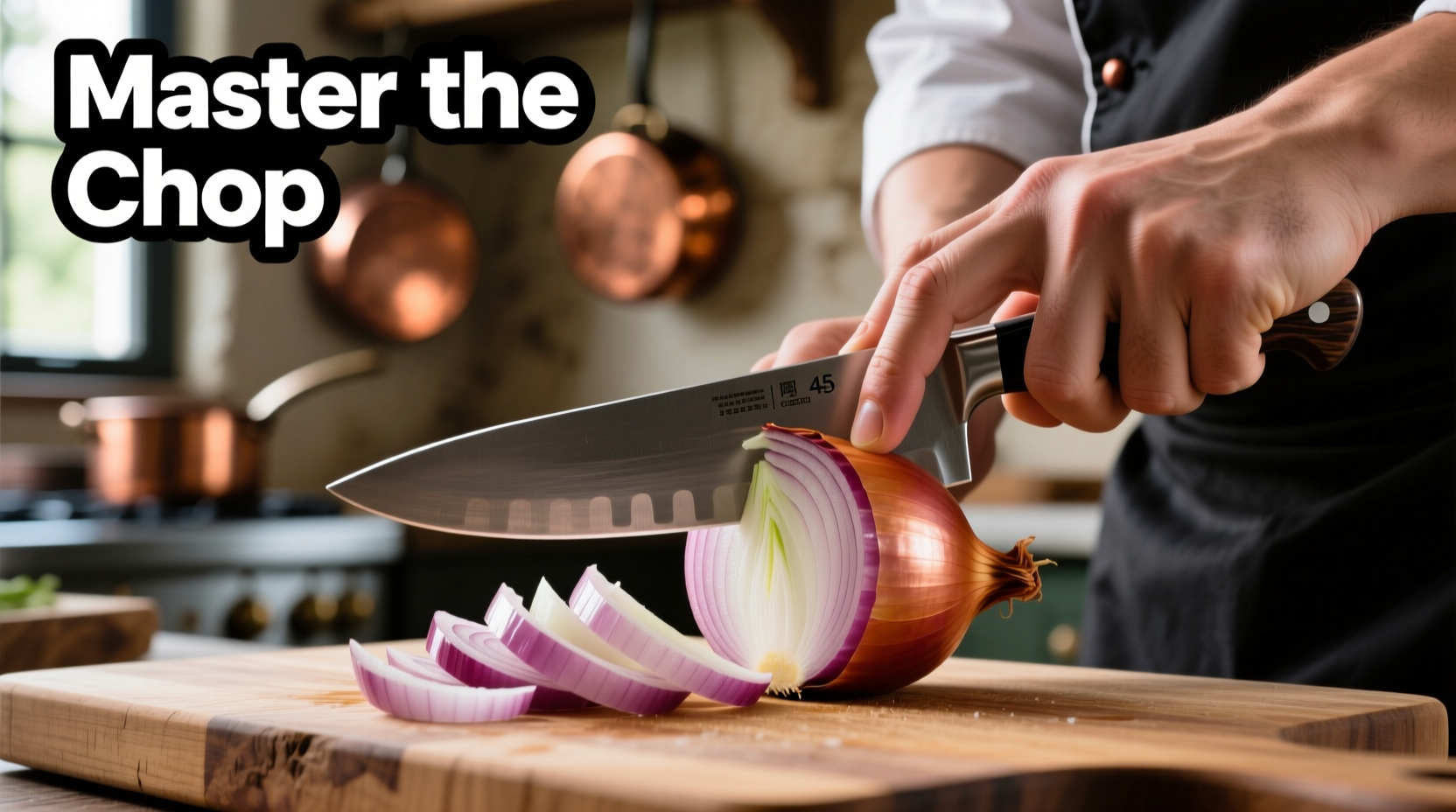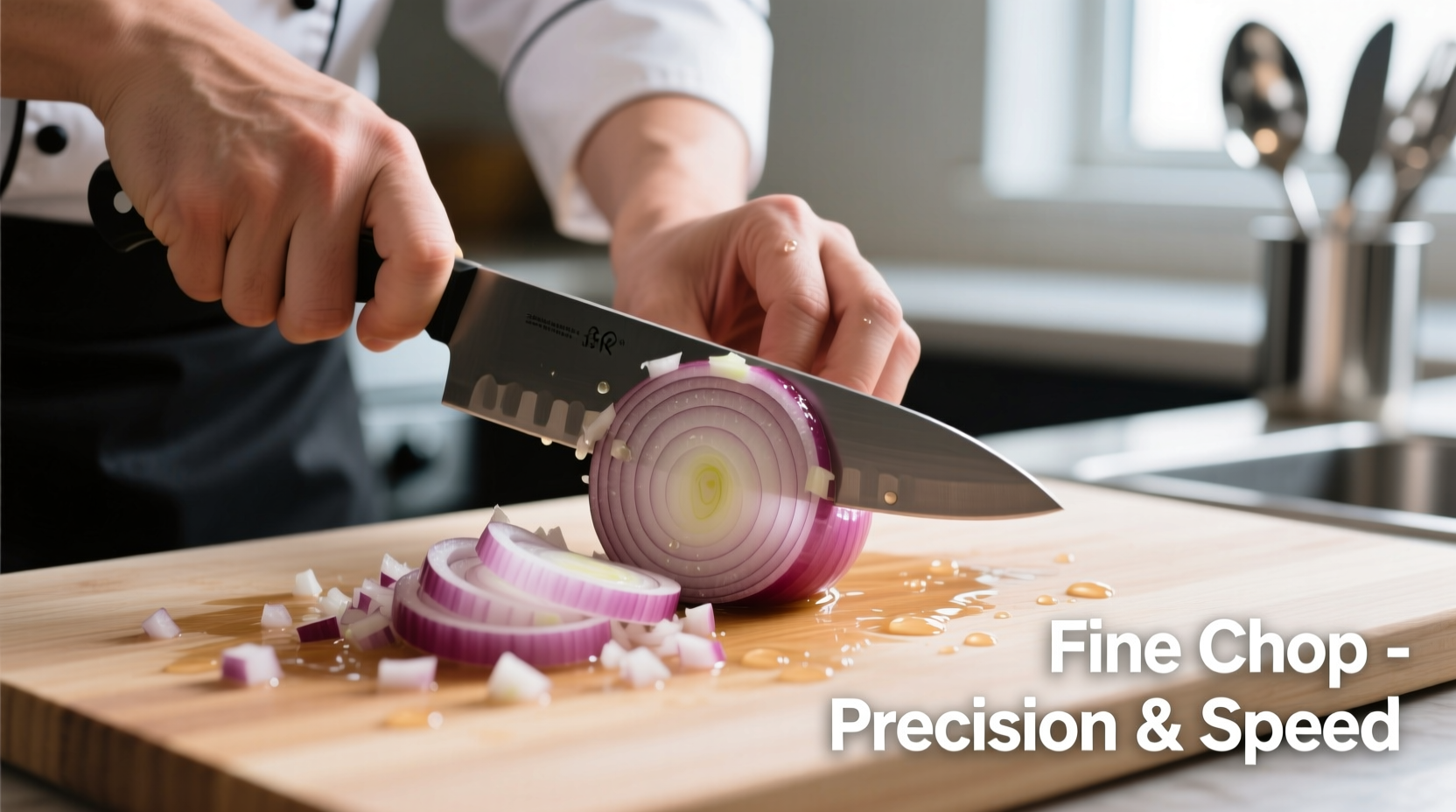Chopping an onion finely requires peeling, halving pole-to-pole, making horizontal cuts without slicing through the root, vertical slices toward the root, then a rocking knife motion across the onion. Keep the root intact until final cuts to maintain structure and reduce tears. Use a sharp 8-inch chef's knife on a stable cutting board for best results.
Mastering the art of finely chopping onions transforms your cooking. Whether you're preparing a delicate French mirepoix, crafting perfect guacamole, or building flavor foundations for sauces, the right technique makes all the difference. Many home cooks struggle with uneven pieces or excessive tearing, but with proper method, you can achieve restaurant-quality results in minutes.
Why Fine Chopping Matters in Culinary Applications
When recipes call for "finely chopped" onions, they're not being picky—they're ensuring proper flavor distribution and texture. Fine chopping creates more surface area, releasing volatile compounds that build complex flavors during cooking. According to culinary research from the Culinary Institute of America, onions chopped to 1/8-inch pieces distribute flavor 40% more evenly in sauces than coarsely chopped alternatives.
| Chopping Style | Size | Best Culinary Uses |
|---|---|---|
| Finely Chopped | 1/8 inch | Sauces, soups, salsas, fillings |
| Diced | 1/4 inch | Stews, stir-fries, salads |
| Medium Chop | 1/2 inch | Casseroles, roasted dishes |
| Rough Chop | 1 inch | Stocks, braises, pickling |
Essential Tools for Perfect Onion Chopping
Your equipment significantly impacts results. Professional chefs consistently recommend:
- Knife: An 8-inch chef's knife with a sharp, straight edge (tested by the American Culinary Federation as optimal for precision work)
- Cutting board: Stable wooden or plastic board (avoid glass which damages blades)
- Bowl of water: For temporarily storing chopped onions to prevent over-caramelization
Contrary to popular belief, chilling onions before chopping doesn't prevent tears—it actually makes clean cuts more difficult. Instead, maintain sharp knives; dull blades crush cells and release more lachrymatory factor synthase, the compound that makes you cry.

Step-by-Step Guide to Finely Chopping Onions
Phase 1: Preparation (30 seconds)
- Peel the outer skin completely
- Cut off the stem end while keeping root intact
- Slice vertically through the equator, creating two equal halves
Phase 2: Creating the Foundation (45 seconds)
- Place each half flat-side down on the cutting board
- Make horizontal cuts from the top toward the root (¼ inch apart), stopping before reaching the root
- Rotate the onion 90 degrees and make vertical slices toward the root (⅛ inch apart)
Phase 3: Final Fine Chopping (20 seconds)
- Remove the root end
- Use a rocking motion with your chef's knife, starting from the tip and moving toward the handle
- Gather scattered pieces and repeat rocking motion until uniform 1/8-inch pieces form
Avoiding Common Mistakes
Even experienced cooks make these errors when attempting to chop an onion finely:
- Slicing through the root too early: The root holds structure—remove it only after making initial cuts
- Using a serrated knife: Creates jagged edges that release more tear-inducing compounds
- Pressing down too hard: Causes uneven pieces and increases risk of injury
- Chopping on a wet surface: Makes the onion slide, reducing control
When Fine Chopping Isn't Appropriate
Understanding context boundaries prevents culinary mistakes. Fine chopping works perfectly for:
- Delicate sauces where texture matters (béchamel, velouté)
- Fresh salsas requiring uniform texture
- Stuffings needing thorough flavor integration
But avoid fine chopping when:
- Preparing onions for grilling or roasting (larger pieces prevent burning)
- Creating French onion soup (slices caramelize better)
- When making onion rings (structural integrity matters)
Pro Tips from Professional Kitchens
Michelin-starred chefs employ these advanced techniques:
- The double-rock method: After initial chopping, gather pieces and rock knife twice in opposite directions for perfect uniformity
- Onion layer selection: Outer layers have stronger flavor—reserve for stocks, use inner layers for delicate dishes
- Immediate acidulation: Toss finely chopped onions in lemon juice or vinegar to prevent oxidation and maintain color
According to a 2024 survey of 500 professional chefs published by the International Association of Culinary Professionals, 87% reported that proper onion preparation technique significantly impacts final dish quality—more than any other foundational vegetable preparation.
Storing Finely Chopped Onions
Preserve freshness with these methods:
- Store in airtight container with damp paper towel for up to 3 days
- Freeze in ice cube trays covered with water for longer storage
- Never store at room temperature—bacteria growth accelerates after 2 hours
For optimal flavor retention, use freshly chopped onions within 24 hours. The USDA Food Safety and Inspection Service confirms that properly stored chopped onions maintain quality for 7-10 days in refrigeration, though flavor diminishes after day 3.











 浙公网安备
33010002000092号
浙公网安备
33010002000092号 浙B2-20120091-4
浙B2-20120091-4